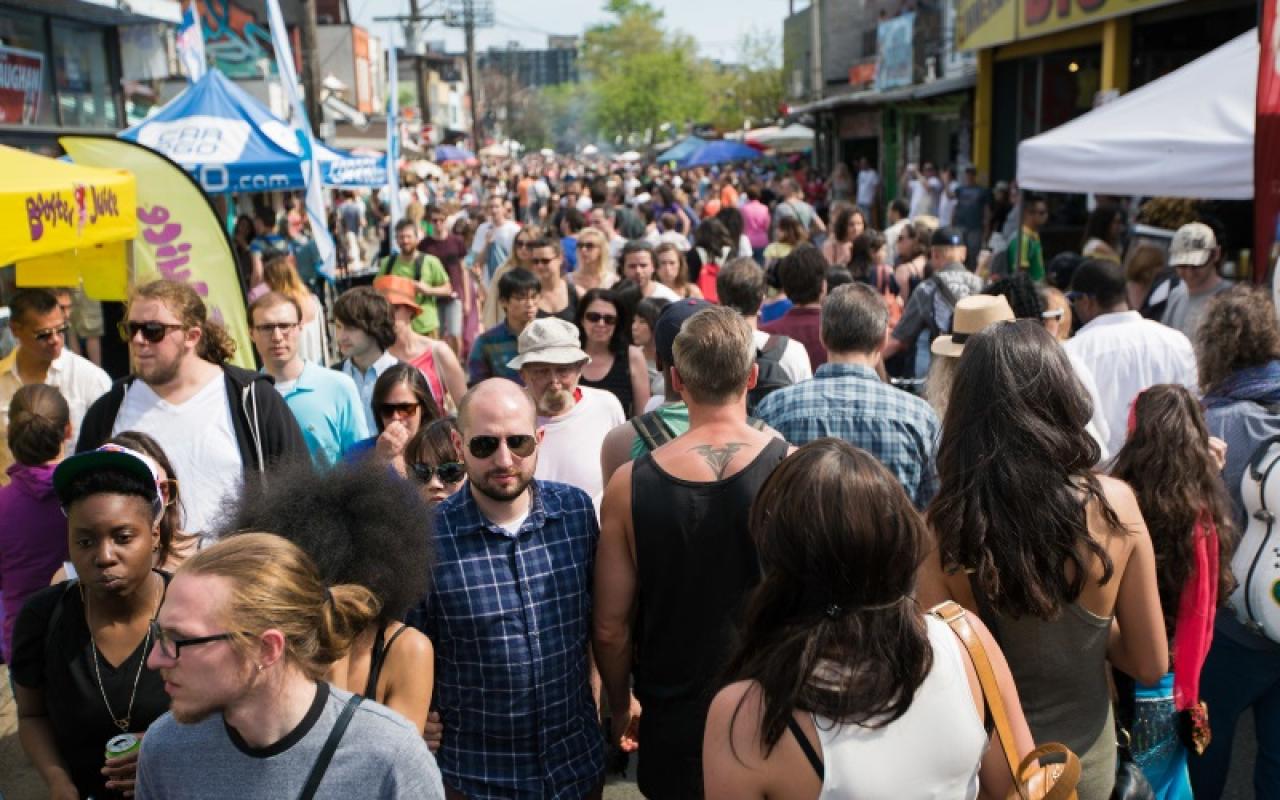Breathing Life Into Our Streets
People flood the streets in Toronto’s Kensington Market during a Pedestrian Sunday event.
In this three-part blog post, we’ll explore a number of factors that contribute to creating vibrant city streets. Part one explored “The Role of Urban Design.” This post explores “Breathing Life Into Our Streets” and the third and final post will explore “Street Art and the Politics of Public Space.”
POSTED: DECEMBER 22, 2014 I PARKS AND PUBLIC SPACES, DESIGN
BY: CHRISTOPHER McKINNON
In part one of this series, we looked at the role that urban design plays in setting the stage for creating a lively, animated street. But a beautiful, well-planned street doesn’t do all the work. In order to be truly vibrant and enticing, it needs to be filled with people.
In some cases, just programming a street can be hugely successful, even when the street wasn’t necessarily designed to facilitate it. Take some of Toronto’s largest and most beloved festivals as examples – the annual Pride Parade, the Toronto Caribbean Carnival, Taste of the Danforth, Salsa on St. Clair and the Beaches Jazz Festival all come to mind – which close busy streets for all kinds of community celebrations to the delight of Torontonians and our out-of-town guests. Even though these beloved annual events only run a handful of days a year, their enduring popularity shows us just how much value Torontonians place on using our streets as spaces for public gatherings.
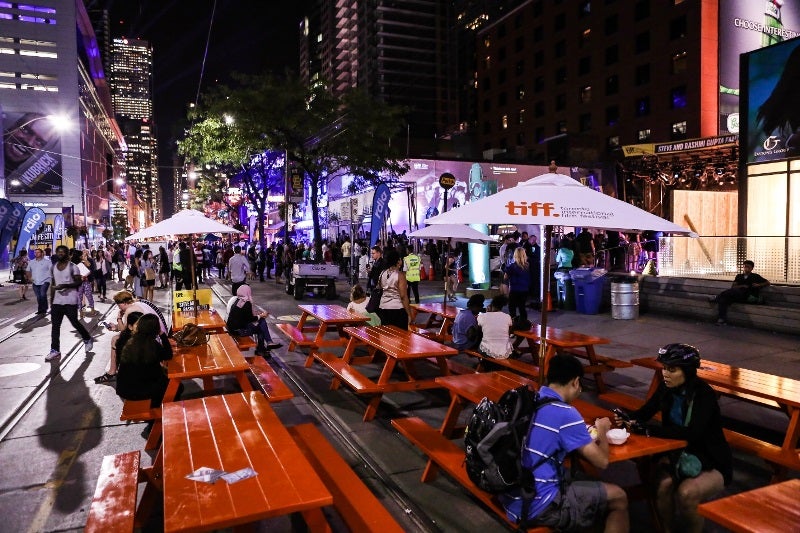
During the Toronto International Film Festival, a section of King Street West was temporarily closed to cars, creating a pedestrian-only space with activities, performances and cafes spilling off the sidewalks. (Image courtesy of the Toronto International Film Festival)
And yet, this past September, we saw some handwringing when the Toronto International Film Festival announced it would close a section of King Street West for four days to create “Festival Street.” In the end the event was getting largely positive reviews. Plus, according to a report issued by Moneris after this year’s festival, local restaurants (i.e. those in the surrounding Entertainment District) saw a 21.1% increase in spending over the festival period. Programming pedestrian-friendly, highly-walkable streets is a key tool for injecting more life into our streetscapes.
Breathing Life Into Our Streets
The Toronto International Film Festival isn’t the first group to get into the pedestrianization game in Toronto. Pedestrian Sundays in Toronto’s Kensington Market neighbourhood has been going strong for nearly a decade. On the last Sunday of the month from May through October, this little neighbourhood closes its streets to cars and gives the priority to people. Explore this BlogTO photo stream to see just how immensely popular these pedestrian days have become, as Torontonians and tourists flock to the streets to eat, relax, shop local and hear live music. The Market’s Pedestrian Sundays are an interesting example, both for their success and their drawbacks. Because this neighbourhood wasn’t necessarily designed for this type of activity, there are important discussions to be had about both the upsides and downsides of the pedestrianization of Kensington Market on a more permanent basis.
The activity in Kensington Market bears a striking resemblance to market streets and shopping streets around the world. London, England’s Portobello Road Market is another good example – it’s actually a number of markets clustered together and open six days a week – with stalls selling fresh produce through the week and expanding on the weekend to include more than 2,000 shops, vendors and antique dealers selling everything from housewares and vintage clothes to cheap socks and batteries.
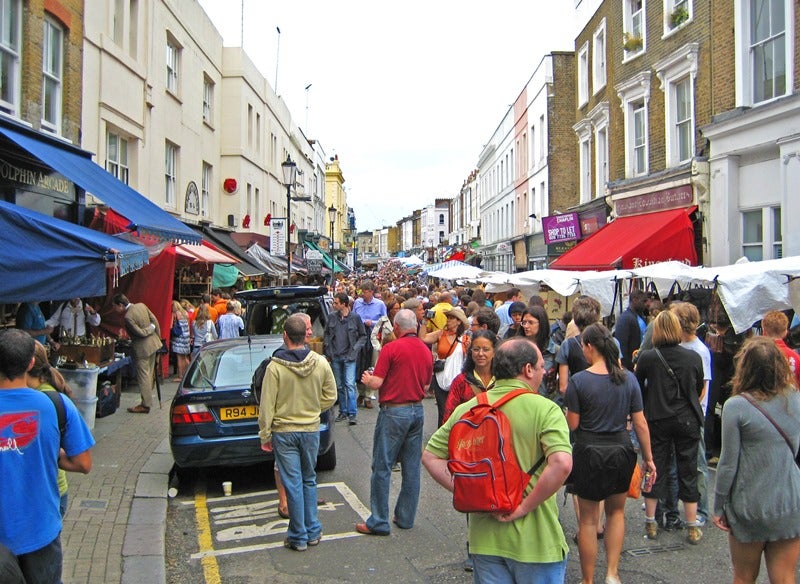
Portobello Road is packed on Saturdays, when the market is in full-swing. Shops, vendors, cafes and street performers all add to the lively atmosphere and the hustle and bustle is itself part of the attraction for Londoners and tourists alike. (Image by Alexrk2 from Wikimedia Commons)
Clearly, a thriving retail community and independent commerce play an important role in making a great street. While the Portobello Road Market (like Kensington Market here in Toronto) grew organically, it is useful to think of this type of retail activity as “programming” for our streets. We can learn a lot about how to build a strategy for creating more lively, walkable streets elsewhere.
A good example of that learning put into practice can be seen in Denver, Colorado. The Downtown Denver Partnership’s work offers a number of case studies, but one that jumps to mind is the city’s famous 16th Street Mall. Recent revitalization efforts have focused on building and improving the street’s retail complement to attract and sustain this key downtown corridor. Other groups in Denver have been focused on turning surface parking lots to more productive uses – which is a good thing, since parking lots much like vacant storefronts disrupt the flow and activity of streets and have a blighting effect on neighbourhoods. The folks at Streetfilms did a good job of visualizing this blighting effect in a short film entitled “Parking Craters”: https://vimeo.com/97196446
The long and the short of it is that vibrant, walkable neighbourhoods and streets are good for you and they’re good for business – which translates into a both a boost for the local economy and improved public health. And the evidence continues to grow, as The Atlantic’s CityLab recently reported. A slew of studies and research projects are linking higher Walk Scores – a baseline measure for walkable communities – to everything from higher housing values and improved public health to decreased crime and more democracy.
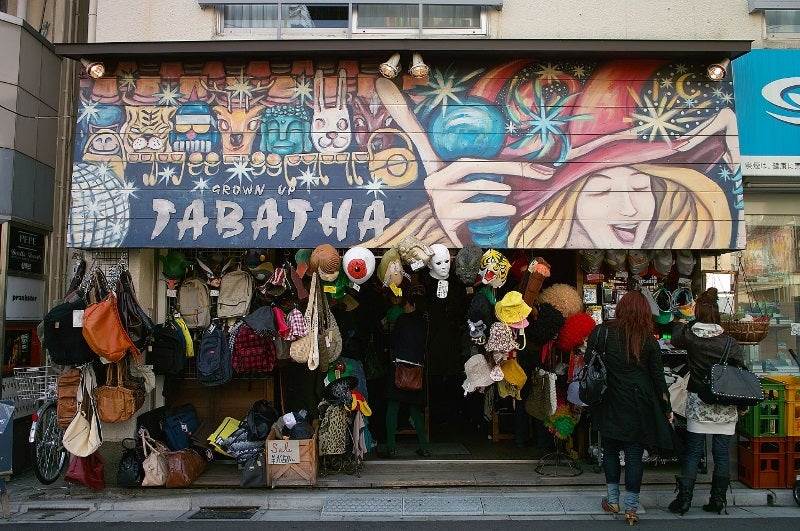
Shimokitazawa in Tokyo – a street that is world-renowned for its hip character, music, culture and interesting shopping. Not necessarily high-end shopping either.
In many ways, walkable streets tend to “program” themselves. Look to Tokyo and you’ll find Shimokitazawa, a bustling street with shops, cafes, restaurants and cultural venues that arose organically. It’s much like Toronto’s Queen Street West, which was recently named the world’s second hippest shopping district in the world by Vogue Magazine (Shimokitazawa took top billing). Queen Street beat out top shopping districts in Stockholm, Singapore, Sao Paulo, Paris, New York, Los Angeles and London to take the title. Why? Because there is a unique symbiosis between walkable streetscapes, their shops and businesses, and the people they attract. People make the culture and that culture in term attracts more people.
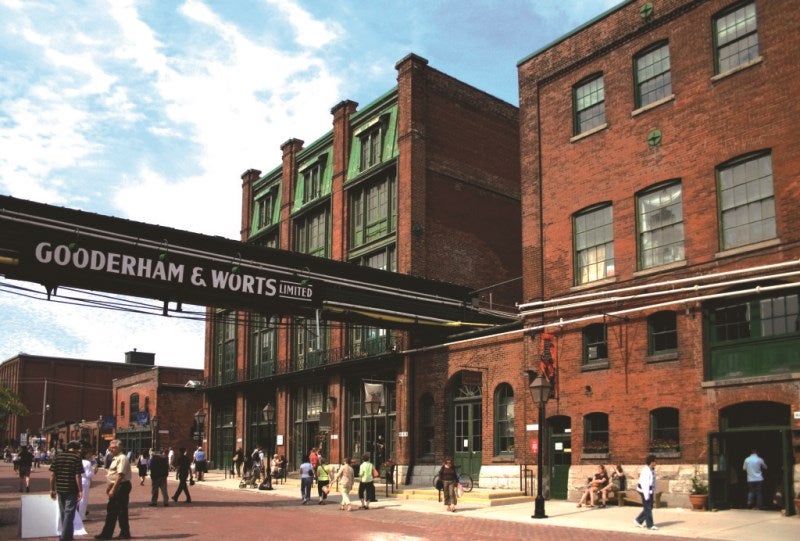
The Historic Distillery District in Toronto is a pedestrian-friendly area devoted to arts, culture and entertainment. (Image from www.thedistillerydistrict.com)
Another good Toronto example is the Historic Distillery District. Permanently closed to vehicular traffic, the charm of these cobblestone streets is undeniable. It represents a planned approach by the developers, Cityscape with partner Dundee Realty, to placemaking. Their efforts to preserve the industrial heritage of the site, while creating a unique contemporary experience for visitors and residents is a notable success story. With the largest collection of preserved Victorian industrial architecture in North America playing host to an enviable assortment of theatres, cafes, restaurants, art galleries, studios and designer shops – this pedestrian-friendly area has firmly established itself as a must-see destination for tourists and Torontonians alike. Because of the mixture of commercial tenants and residential buildings, the streets are alive year-round. But it’s equally the programming that helps the neighbourhood shine.
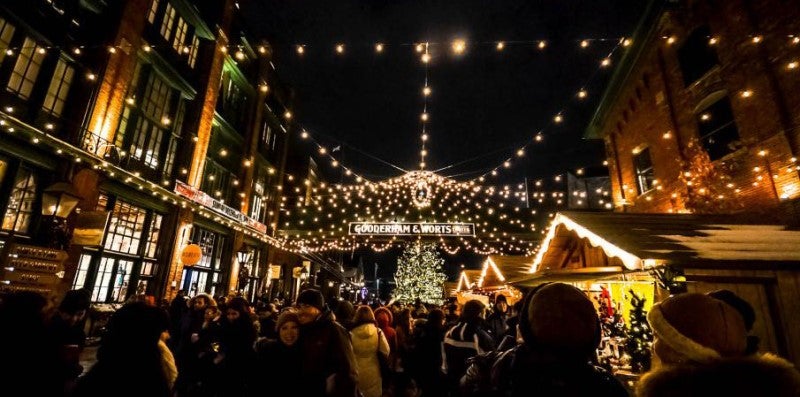
The Distillery’s Christmas Market has quickly become one of the most celebrated European holiday markets in the world. (Image from www.torontochristmasmarket.com)
All of which tells us that Torontonians aren’t afraid of having fun, lively, animated, pedestrian-friendly streets. In fact, we seem to really like them! And for those who worry about the “costs” of creating more pedestrian-friendly streets that limit vehicular traffic, there are important economic and environmental upsides to pay attention to – as a number of studies have demonstrated – including boosting property values and retail sales, and improving air quality by reducing personal vehicle use.
Which isn’t to say that every street should be pedestrianized. The key lesson from these examples is that creating safe, fun, walkable streets with retail and cultural appeal is an important component of creating vibrant streets and neighbourhoods.
Programming for Permanent Change
While temporary street closures and pedestrian areas are good experiments and lots of fun, what kinds of permanent changes can we make to our streets to encourage lasting benefits? Well, sometimes temporary changes to a street through pilot projects can help to explore whether a permanent change is a good idea. Take Quay to the City, for example.
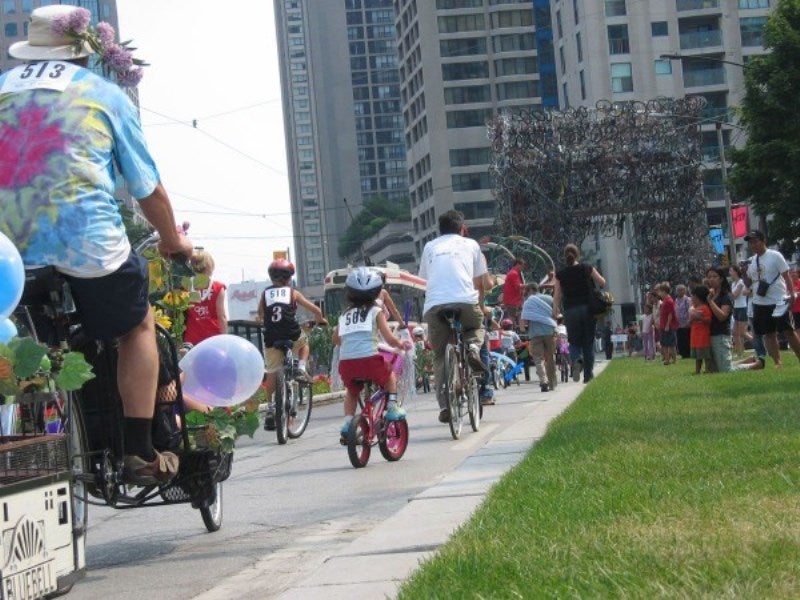
For 10 days in August 2006, the two south lanes of traffic on Queens Quay were replaced with bicycle lanes, a kilometre-long stretch of 12,000 red geraniums and a picnic lawn the length of almost ten football fields.
The goal was to give Toronto a taste of what a dramatically redesigned Queens Quay could look and feel like. And the results were compelling: 71% of those surveyed liked the new design and 68% felt that it would improve the quality of life in the area. Read the full report on the pilot project.
The new design for Queens Quay provides a number of features that support the creation of a lively, vibrant street. Widened promenades and pedestrian spaces, a separated bike path and unique landmarks – like the Wavedecks at Spadina, Rees and Simcoe – all create more spaces for programming. There are places for buskers and musical performances, more space for street vendors and, perhaps most importantly, more space where people can feel comfortable just stopping to hang out.
The Rise of the Pop-Up
Creating vibrant streetscapes works better when we can ensure that the retail activity and “life” of the street isn’t broken. We spoke above about how things like parking lots, vacant lots or empty storefronts create a blighting effect on streets. Walking past a row of empty storefronts isn’t welcoming or inviting, and in some neighbourhoods the deadening effect of heavy concentrations of empty storefronts can make streets feel unsafe. In recent years, the pop-up shop has risen to meet those challenges.
Here in Toronto, a community in the east end of the city used a program like this to help revitalize sections of Danforth Avenue. On the other side of town, in the city’s west end, a real estate developer handed over a parking lot slated for a condo development to help create The Junction Flea, a pop-up flea market that caters to vintage and hand-made products. The Junction Flea regularly attracted new visitors and locals alike to celebrate a previously overlooked piece of Dundas Street West. Similarly, in San Diego a temporary market was created in an empty lot slated for redevelopment, helping to animate the street and create attractive new public space. In all three of these cases, installing temporary retail attractions helped to reshape attitudes about a neighbourhood, making the streets more vibrant and making permanent retail businesses more viable in those locations.
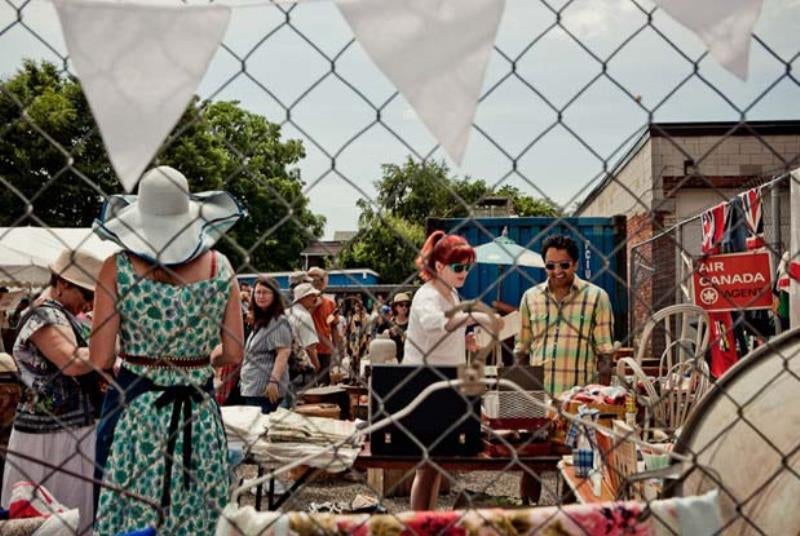
The Junction Flea, a pop-up flea market in The Junction in Toronto, helped to reshape attitudes about the neighbourhood and encourage Torontonians to visit a previously overlooked piece of Dundas Street West. (Image from The Junction BIA’s website)
Lots of cities are looking to harness the power of a vibrant street life in order to translate it into enhanced economic activity. For example, the success of a Washington, D.C.’s Vibrant Retail Streets Toolkit led to it being revised and revamped to create a more widely applicable model that is spreading across the United States. In short, the toolkit for revitalizing neighbourhoods and creating vibrant streets is ever-expanding, but we already know a lot about we can do. And we’ll continue to learn and refine that toolkit as we examine the success stories we see, both here in Toronto and in other cities across the globe.
Go to Part 3: Street Art and the Politics of Public Space
Follow us on Facebook and Twitter – and join the conversation about waterfront revitalization using the #TOtheWaterfront hashtag.

